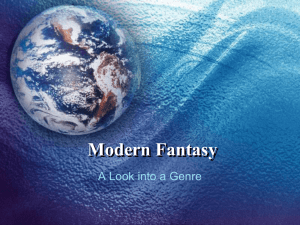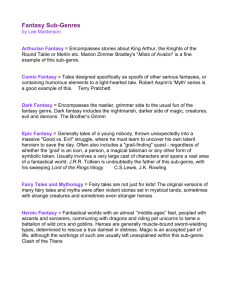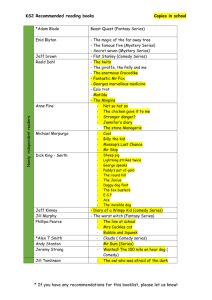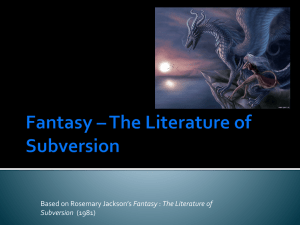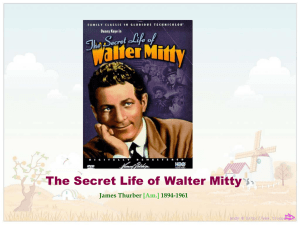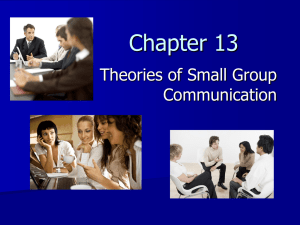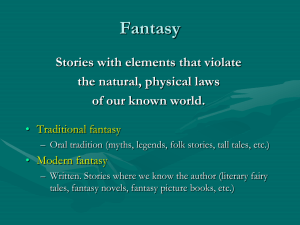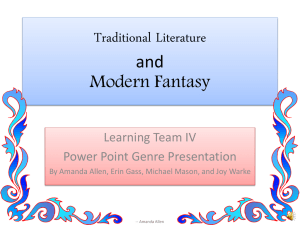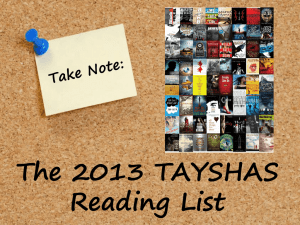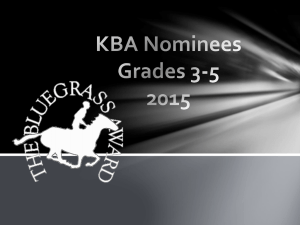Modern Fantasy - Department of Reading and Language Arts
advertisement
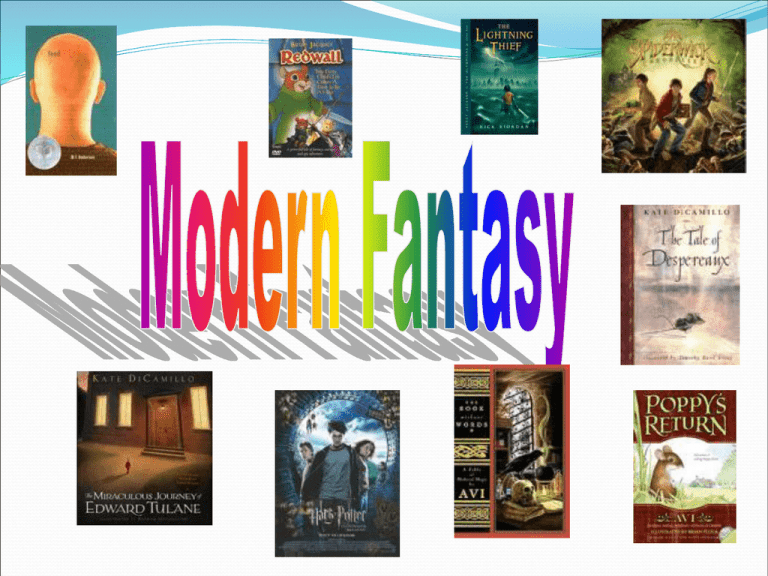
What are some of its Key Features? Elements that violate the natural physical laws of our world- events akin to magicWith known authors Credibility is key Issues the examine the human condition and universal truths Definition of Modern Fantasy Fantasy is imaginative narrative that explores alternative realities Fantasy •suspends disbelief •suspends scientific explanations and natural laws •is unaccountable to the known world source: Cullinan & Galda, 1994, p. 199 What about modern fantasy? Credibility is key •Is every action consistent with the framework developed by the author? •Can the reader suspend disbelief about the characters? •How does the author’s characterization allow the reader to suspend disbelief Do characters begin in the real world? Does the author use appropriate and believable language consistent with the story? •Is the setting consistent allowing the reader to understand the world that is created. •If the author creates several time periods are the settings authentic and integral to the story? •Does the author pay careful attention to details in the story? •Are the characters actions consistent with the setting? •Is the theme of value and important for children? 1. Does the story act as a metaphor for life? Does the story: tell the truth about life clarify the human condition capture our deepest emotions, dreams, hopes, and fears 2. Is the story rooted in reality? Is it believable? Is the fantasy world believable within the context of the story? Can you visualize the setting? Can the reader feel, see and hear the setting? Are new worlds convincing? Are lots of details used? 3. Internal Consistency Are the settings and events consistent throughout the story? Are the fantasy elements logically integrated? Is there an original and imaginative concept? Is the action believable, consistent, and natural in the story? Does it allow the reader to suspend disbelief? Is there a smooth transition between the real and unreal world? 4. Characterization Are the characters well developed and believable? Are characters true to themselves? Does the character’s motivation make sense in the context of the story? Can the reader identify with the protagonist? 5. Universal Truth Is there a universal truth underlying the metaphor of the fantasy? Is there a worthwhile theme? Do the characters represent a universal value? Figure 2: Traditional Fantasy vs. Modern Fantasy BOTH genres are fantasies TRADITIONAL FANTASY They from the oral tradition of collected stories. The setting is often vague and magical. Characters are symbolic and do not grow and change. and portray other worlds, with elements of magic, talking animals, strange characters, and objects, can include s/heroe's journey, supernatural, universal themes of good versus evil, right versus wrong etc. Both can be allegorical, spiritual, satirical, and political. MODERN FANTASY Stories are associated with an author. Setting is detailed and key and should be credible. Characters grow and change. TYPES OF MODERN FANTASY Modern Folktales or Literary Folktales: very little character description/strong conflict/fastmoving plot/sudden resolution/vague setting -- known author. The Ugly Duckling, Peter Rabbit Animal Fantasy: animals behave as human beings/personified yet retaining many of their animal characteristics. Catwings Charlotte’s Web, Poppy books (Avi) Personified Characters and Objects: toys brought to life and believed in/often responsibility of parenthood assumed by the child protagonist Winnie the Pooh, Pinocchio Unusual Characters and Strange Situations: strange or ridiculous Alice’s Adventures in Wonderland, Pipi Longstocking Worlds of Little People: miniature people with a culture or world of their own. Children identify with indignities foisted upon little & powerless people/big people usually outdone by clever little people. Gulliver in Lilliput, The Borrowers Supernatural Events and Mystery Fantasy: ghost stories. Ghosts can be fearful threats or helpful protectors. The Boggart Historical Fantasy: timewarp fantasy. Time period must be fully & accurately developed. Stone Words, The Root Cellar, The Devil’s Arithmetic Quest Stories: adventure stories with a search motif. High fantasy/often set in medieval times/imaginary worlds/conflict between good and evil/characters drawn from myth and legend. Quest usually represents a journey of self-discovery and personal growth for protagonist. The Hobbit (Tolkien) The Wizard of Oz Science Fiction (imaginative lit about something that could happen based on real scientific facts and principles/ Must have appearance of scientific or technical plausibility About future worlds. Called futuristic fiction) (a scientific explanation/not necessarily plausible/offered for imaginative leaps into the unknown. Presents a world that is a mix of mythology and traditional fantasy with scientific or technological concepts. A Wrinkle in Time, The Giver, Feed 4. Heroism and the Hero’s Quest Hero follows pattern of: •called to adventure by some sort of herald •crosses threshold into unsafe and insecure place •survives •assisted by protective figure •matures •returns home The Wonderful Wizard of Oz (L. Frank Baum) Fantastic worlds Oz Time shifts Fantastic Characters Good Witch of the North; Wicked Witches of East and West Tin Woodman Cowardly Lion Scarecrow Flying Monkeys Munchkin people Fantastic Objects Magic silver shoes Magic golden cap Talking Animals Talking stork Flying monkeys Magic Magic of characters, objects and Fantastic world Multiple Interpretations Entertainment, Political Manifesto Spiritual Journey Call to the Quest The Cyclone Guides and Helpers Scarecrow Tin Woodman, Cowardly lion Flying monkeys Glinda Quest Challenges Get to the City of Emeralds, Meet the wizard, Search for the wicked witch Kill the witch Return to Oz The Goal of the Quest To return home, To learn, become courageous, and grow in heart , to discover one’s own inner power The Journey Home Finding Glinda Returns to Kansas with loved ones James and the Giant Peach (R.Dahl) Harry Potter and the Half-Blood Prince (J.K. Rowling) What is your book's Fantasy Quotient? Name of Book Magic Other worlds Good versus evil Hero’s Round/Quest Fantastic character types Fantastic objects Debates Drama: Plot Extension Select a scene and pretend it continues. What would characters say to each other? Have students create a Readers Theatre from a scene and perform it. Art: Draw characters as you see them. Create a mural of the strange world created in the story Storytelling Fractured Fairy Tales Project This site is devoted to many different primary and intermediate classes around the United States and Canada that have written fractured fairy tales. It has a section that links out to other sites. http://www.desertskyone.com/FT/#top Children’s Books Hans Christian Anderson http://childrensbooks.about.com/gi/dynamic/offsite.htm?zi=1/XJ/Ya&sdn=childr ensbooks&cdn=p
